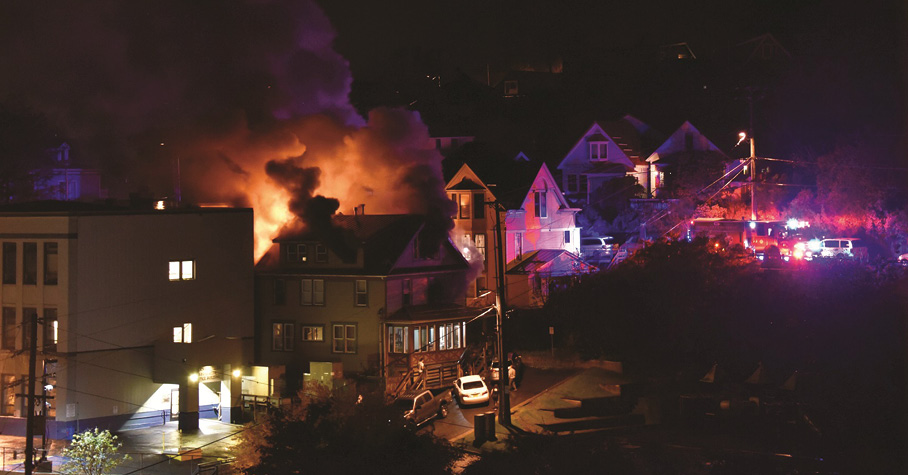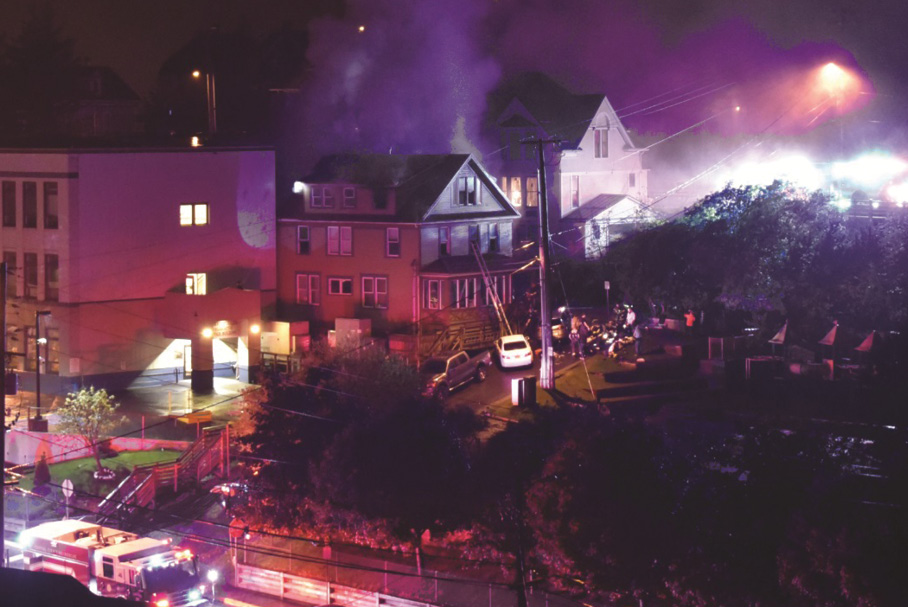
By NOAH T. JENKINS
On September 16, 2017, at 0430 hours, an “all-call” dispatched the entire Capital City Fire/Rescue (CCFR) in Juneau, Alaska, to a working structure fire a half mile from Station One in the downtown district. At this incident, our staffing levels necessitated making compromises to the fireground tactical priorities, which led to delays in rescue, exposures, confinement, extinguishment, and overhaul (RECEO).

(1) The first engine arrives. One victim is clinging to the roof on the A/B corner. (Photos by Martha Taylor.)
CCFR is a combination department that responds to 5,000 emergency calls annually. There are two staffed stations nine miles apart, with minimum staffing levels of a captain and an engineer on the engine and two firefighters assigned to an ambulance. Our department, like most combination departments, has seen a drastic drop in participation and retention of volunteers over the past decades. The volunteer staff has a roster of 25 certified firefighters, many of whom struggle to meet the minimum participation and training requirements. Juneau, with a population of 33,000, is surrounded by deep fjords and a 100-mile-wide ice field, so there are no roads in or out of the city. As a result, the department has no mutual-aid options.
Dispatch notified responding units that the 911 caller was trapped inside the building. One person had jumped out of a window, and there were reports of several people still inside the structure. The first-arriving engine and ambulance with a total of four personnel parked on the street above the fire and accessed the structure through a metal grate sidewalk/staircase. Significant fire was observed on the C side of the three-story, 115-year-old wood-frame structure. A “general recall” was requested to alert off-duty staff of the incident.
Like many fire departments across the nation, CCFR does not meet the recommendations in NFPA 1710, Standard for the Organization and Deployment of Fire Suppression Operations, Emergency Medical Operations, and Special Operations to the Public by Career Fire Departments, and 1720, Standard for the Organization and Deployment of Fire Suppression Operations, Emergency Medical Operations, and Special Operations to the Public by Volunteer Fire Departments, which recommends/establishes the resources that should respond to a fire within the first 10 minutes of notice as well as the staffing necessary to perform throughout the duration of the incident. NFPA 1720 reads, in part, “The fire department shall have the capability for sustained operations, including fire suppression; engagement in search and rescue, forcible entry, ventilation, and preservation of property; accountability for personnel; the deployment of a dedicated rapid intervention crew; and provision of support activities for those situations that are beyond the capability of the initial attack.”
Response Tactics
At the above incident, the first-arriving officer ordered a 2½-inch hoseline to be deployed off the static bed because the fire was out of the reach of the preconnected lines. A 360° reconnaissance/assessment was not conducted because the house was set back from a state office building by fewer than 10 feet on the C side. The house had been divided into three separate living units and had a partially enclosed rear exterior staircase that was fully involved. Multiple people were outside the structure yelling that people were inside. Several police officers were already on scene and had searched and cleared the first floor.
Victims and Compromises
A victim who had jumped out of the third-floor window had leg injuries and severe lacerations to his arms. He was lying in front of the building. One female had exited a dormer window onto the 6:12 pitched metal roof and was spotted on the A/B corner; this was the first compromise that had to be made. She was about 25 feet off the ground, screaming for help.
The first-arriving officer decided to concentrate on the fire attack and delay the rescue until more staff arrived. The officer and two ambulance firefighters (both still on probation) pulled the 2½-inch line to the D side, where they were able to knock down most of the exterior fire quickly.
The crew then advanced the 2½-inch line up the exterior staircase to the third-floor kitchen, which had become fully involved. After most of the fire was knocked down, the officer left the firefighters on the hose to conduct a primary search. The first unconscious victim was located in a doorway between the living room and a bedroom. The firefighters from the hoseline were summoned to assist in removing the nearly 300-pound victim. A short prusik cord was looped around the victim’s ankles to assist in pulling him out. The fire had reignited on the exterior staircase and, prior to members bringing him down the stairs, the fire had to be knocked back again.
While the officer and two ambulance firefighters conducted the fire attack and search and rescue operations, the engineer, after charging the attack hoseline, delayed getting a water supply from a hydrant—another compromise necessitated by our staffing levels. Instead, he commenced the rescue of the victim on the roof. The engineer deployed a 24-foot ladder to the front porch and then returned to the engine to retrieve a 14-foot roof ladder, which he was able to raise and heel on the metal snow stop on the porch roof. The metal roof was extremely slippery because it had been raining. The engineer ordered a civilian, who had climbed up to assist, to stabilize the roof ladder on the snow stop while he heeled the ladder from the back side. He then verbally coaxed the victim from the roof onto the ladder. Once she was down safely, the engineer entered the second floor and conducted a quick primary search, finding no victims. He also located a very small staircase on the A side of the house.
While carrying the first victim down, the crew ran out of air while they were still in heavy smoke on the deck. At this point, because there was no one else to relieve them, they had two options: (1) leave the victim where he was and go get fresh bottles or (2) compromise their own health and safety and remove their masks. They opted to remove their masks while continuing to drag the victim down to the street, where they started cardiopulmonary resuscitation (CPR).
Second Crew Arrives
Ten minutes after the first crew’s arrival, the duty officer, the second engine, and the second ambulance arrived. This brought the total number of personnel on scene to nine. The second crew was assigned to secure a water source and continue the primary search. The first-arriving officer met up with the second-arriving officer and made entry on the C side. The second-arriving ambulance crew made its way to the third floor by the interior staircase the engineer had located.
The two crews met on the third floor and located the second victim in the living room. They brought the victim down the interior staircase to the street, where they initiated CPR. Both victims were shocked multiple times, regained their pulses, and were transported to the hospital four miles away. A police officer transported the victim who had jumped out of the window to the hospital. A total of seven off-duty staff and four volunteer firefighters eventually arrived to assist. Transporting the two critical victims took eight firefighters away from the already understaffed scene. Unfortunately, these two victims died later at the emergency room (ER).
Injured Firefighters
The two firefighters who had to remove their masks during the rescue were vomiting and coughing because of smoke inhalation and were ordered to check into the hospital. However, as they represented the only in-service ambulance in the city, prior to being checked in, they were directed to return to the fire scene to transport the female who was rescued from the roof and who was also suffering from smoke inhalation.
Shortly after delivering her to the hospital, the injured firefighters were once again summoned to return to the fire scene for a firefighter who was suffering symptoms of heat exhaustion. As they were treating and transporting this firefighter to the hospital, there was an unrelated call in another part of the city for a patient with respiratory distress. The firefighter who was suffering from heat exhaustion removed his oxygen mask, got off the gurney, helped remake the cot, and then assisted in the treatment of the respiratory patient. Once the three injured firefighters delivered this patient to the ER, they checked themselves in as patients for assessment and treatment.
The fire was not declared out until more than four hours after the initial callout. Because the fire had spread into void spaces (that are all too common in homes of this age), the overhaul was difficult. With staffing levels so low, firefighters were required to work through as many as five self-contained breathing apparatus bottles. On several occasions, the fire broke out of the void spaces; it looked like the crews might have to move to a defensive posture (photos 1-4) .

(2) After the initial knockdown, CPR was performed on two victims in the front of the building.

(3) The fire in the void spaces was difficult to extinguish. It appears here that crews may have to move to defensive operations.

(4) The final stages of extinguishment, four hours after the initial dispatch.
Postincident Analysis
With staffing levels below those recommended by the NFPA, not all fireground tactics can occur as efficiently as they should. At this incident, compromises were made that led to a delay in rescue, the need to use citizens to assist in the rescue, the need to transport an injured civilian in a police car, a delay in securing a water supply, the need for firefighters to remove their masks while still in heavy smoke, the need to use injured firefighters to treat and transport multiple patients to the hospital prior to seeking treatment for themselves, and overexertion by all the firefighters on the scene. Some considered this incident a success because the fire was contained to the building of origin and no firefighters were severely injured. However, with adequate staffing, the tactical priorities of RECEO might have occurred more quickly, avoiding a tragic loss of life.
Postincident, the city hired a consulting company to assess our department, specifically regarding our staffing levels. The consulting company completed the report, and an additional ambulance will now be staffed. However, the CCFR still runs only two members on the engine, and we do not have a staffed ladder company.
The current administration and the union are working together to show the city leaders that the department is in need of more staffing. It is the hope that this fire, which resulted in two deaths, three civilian injuries, and four injured firefighters, may help reveal that our current staffing levels not only reduce our ability to complete our mission but also put firefighters at risk.
NOAH T. JENKINS is a 15-year member of and a captain for Capital City Fire/Rescue in Juneau, Alaska.

